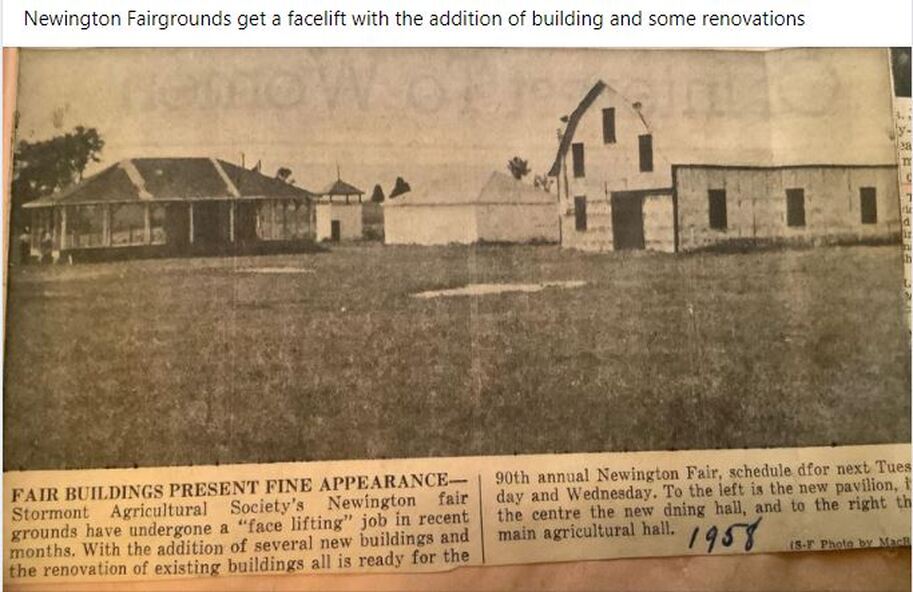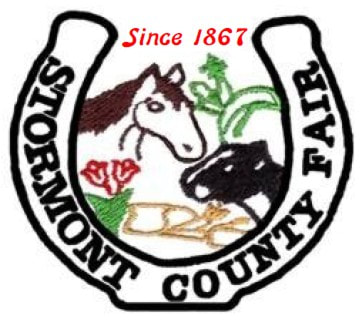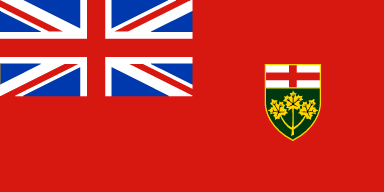Stormont County Fair History
The Stormont County Fair began in a field East of Willard Wereley’s. It then made its way to Osnabruck Centre, until 1867, when the official Stormont Agricultural Society was formed and was permanently held in Newington henceforth.
Originally, exhibits were displayed at McAvoy’s Hotel, then owned by Jacob Baker. Eventually land was acquired from G.F. Jardine where a two-story exhibition hall was built and there was a quarter-mile racetrack.
In 1926 the fair moved to its present location when land was purchased from J.W. Duvall. This was a big step for the Society. The new grounds now had a half-mile racetrack and the newly built exhibition hall was then moved on site, taken across fields and over a creek to its new location.
Post cards were sold as advertising to benefit the fair, as it was a major local event. Horses and drivers would usually arrive two days prior to the fair opening, filling the hotel. The stalls at the fairgrounds were filled with animals.
The exhibition hall featured locally made and manufactured products for judgement, including: a tub of butter, not less than forty pounds; fifteen pounds of homemade cheese; ten pounds of maple sugar; a half gallon of maple syrup; four pound pieces of honeycomb; a collection of seedling apples. The manufacturers’ section included: ten yards of each of homemade cloth flannel, yarn carpet, rag carpet, linen, and two pound twisted yarn; two skeins of linen thread; and one pair of fine boots.
Homemade implements were also listed. One was the best churn in action. Prizes ranged from fifty cents to three dollars.
One of the first buildings to be erected was the office in 1957, with an extension in 1983. Another was the grandstand in 1958, with an addition of 25 feet in 1961. The ball diamond was electrically lit for the first time in 1956. But, most of the changes came in 1961. The fair became a three-day event and for the first time was held on the Labour Day holiday weekend.
The cattle shelters accommodating 400 heads of cattle were built that summer and the Jersey Parish show was held here for the first time.
The pavilion, which was bought and moved from Farran’s Point was fixed up, ready for use, especially for the dances.
The work was mostly voluntary except for the grandstand addition when the labour was hired.
1961 was a big year for the Stormont County Fair, and a very successful one.
For a few years the fair was referred to as the “Newington Fair”. This was stopped in all advertising in 1962 and changed to the Stormont County Fair to encompass the fair’s roots and for recognition of being a fair in existence for over 100 years.
In 1963 the new exhibition hall was built, with the western part which included the dining hall, added the following year.
In 1969 the part north of the dining hall was turned over entirely to the 4-H program.
The horse show has always been a main attraction. In 1960 there were 18 horses and no ponies. In 1969 there were 41 horses and 118 ponies!
In 1966 the Stormont County Fair became recognized as a “Class B” fair, meaning that it paid out over $5000.00 in prize money, not including 4-H.
Prize money paid out during that time increased by leaps and bounds: $2789 was paid out in 1962, $4500 in 1965 and $8620 in 1969.
Societies marking a centennial were eligible for a $1000 grant from the Department of Agriculture to spend on the entrance to the grounds with a suitable plaque. So, in 1967, the memorial entrance was built and the Society officially celebrated its 100th anniversary in 1967. This entrance has been made very attractive with its borders of flowers and evergreens.
Since the centennial, the fair has continued to grow. The 4-H calf competition was added in 1970; and new buildings have been erected: Stormont Hall in 1978 and a new barn to stable the cattle in 1980. The midway has also proved popular in recent years. Stormont Dome was erected in 2016. Stormont Hall had the inside updated with pine boarding. Most of the lifeskills and 4-H exhibits now are displayed in Stormont Hall. Horil Ring (permanent outdoor Horse Ring) was completed in 2017.
2020 was a year unlike few others. COVID-19 struck Canada in March and everyone was pretty much in lock-down of some degree for the rest of the year. COVID-19 spread across the world well before the end of the year. Masks, hand-washing and social distancing became part of regular day to day activities if outside your home or having a visitor in. In Canada, it crippled the recreation/entertainment sector and Stormont County Fair had to be cancelled to keep everyone safe. In Canada, no fairs were able to provide their normal activities. Some tried some virtual or display events. Meetings were done virtually. Any in-person event was done with strict health guidelines. Vaccines started to be available in 2021, but the number of cases and deaths continued to climb in 2021.
The fair has many attractions, something of interest for all ages. Its success has been due to the time spent and work done over the years by many interested persons.
The Stormont County Fair began in a field East of Willard Wereley’s. It then made its way to Osnabruck Centre, until 1867, when the official Stormont Agricultural Society was formed and was permanently held in Newington henceforth.
Originally, exhibits were displayed at McAvoy’s Hotel, then owned by Jacob Baker. Eventually land was acquired from G.F. Jardine where a two-story exhibition hall was built and there was a quarter-mile racetrack.
In 1926 the fair moved to its present location when land was purchased from J.W. Duvall. This was a big step for the Society. The new grounds now had a half-mile racetrack and the newly built exhibition hall was then moved on site, taken across fields and over a creek to its new location.
Post cards were sold as advertising to benefit the fair, as it was a major local event. Horses and drivers would usually arrive two days prior to the fair opening, filling the hotel. The stalls at the fairgrounds were filled with animals.
The exhibition hall featured locally made and manufactured products for judgement, including: a tub of butter, not less than forty pounds; fifteen pounds of homemade cheese; ten pounds of maple sugar; a half gallon of maple syrup; four pound pieces of honeycomb; a collection of seedling apples. The manufacturers’ section included: ten yards of each of homemade cloth flannel, yarn carpet, rag carpet, linen, and two pound twisted yarn; two skeins of linen thread; and one pair of fine boots.
Homemade implements were also listed. One was the best churn in action. Prizes ranged from fifty cents to three dollars.
One of the first buildings to be erected was the office in 1957, with an extension in 1983. Another was the grandstand in 1958, with an addition of 25 feet in 1961. The ball diamond was electrically lit for the first time in 1956. But, most of the changes came in 1961. The fair became a three-day event and for the first time was held on the Labour Day holiday weekend.
The cattle shelters accommodating 400 heads of cattle were built that summer and the Jersey Parish show was held here for the first time.
The pavilion, which was bought and moved from Farran’s Point was fixed up, ready for use, especially for the dances.
The work was mostly voluntary except for the grandstand addition when the labour was hired.
1961 was a big year for the Stormont County Fair, and a very successful one.
For a few years the fair was referred to as the “Newington Fair”. This was stopped in all advertising in 1962 and changed to the Stormont County Fair to encompass the fair’s roots and for recognition of being a fair in existence for over 100 years.
In 1963 the new exhibition hall was built, with the western part which included the dining hall, added the following year.
In 1969 the part north of the dining hall was turned over entirely to the 4-H program.
The horse show has always been a main attraction. In 1960 there were 18 horses and no ponies. In 1969 there were 41 horses and 118 ponies!
In 1966 the Stormont County Fair became recognized as a “Class B” fair, meaning that it paid out over $5000.00 in prize money, not including 4-H.
Prize money paid out during that time increased by leaps and bounds: $2789 was paid out in 1962, $4500 in 1965 and $8620 in 1969.
Societies marking a centennial were eligible for a $1000 grant from the Department of Agriculture to spend on the entrance to the grounds with a suitable plaque. So, in 1967, the memorial entrance was built and the Society officially celebrated its 100th anniversary in 1967. This entrance has been made very attractive with its borders of flowers and evergreens.
Since the centennial, the fair has continued to grow. The 4-H calf competition was added in 1970; and new buildings have been erected: Stormont Hall in 1978 and a new barn to stable the cattle in 1980. The midway has also proved popular in recent years. Stormont Dome was erected in 2016. Stormont Hall had the inside updated with pine boarding. Most of the lifeskills and 4-H exhibits now are displayed in Stormont Hall. Horil Ring (permanent outdoor Horse Ring) was completed in 2017.
2020 was a year unlike few others. COVID-19 struck Canada in March and everyone was pretty much in lock-down of some degree for the rest of the year. COVID-19 spread across the world well before the end of the year. Masks, hand-washing and social distancing became part of regular day to day activities if outside your home or having a visitor in. In Canada, it crippled the recreation/entertainment sector and Stormont County Fair had to be cancelled to keep everyone safe. In Canada, no fairs were able to provide their normal activities. Some tried some virtual or display events. Meetings were done virtually. Any in-person event was done with strict health guidelines. Vaccines started to be available in 2021, but the number of cases and deaths continued to climb in 2021.
The fair has many attractions, something of interest for all ages. Its success has been due to the time spent and work done over the years by many interested persons.



